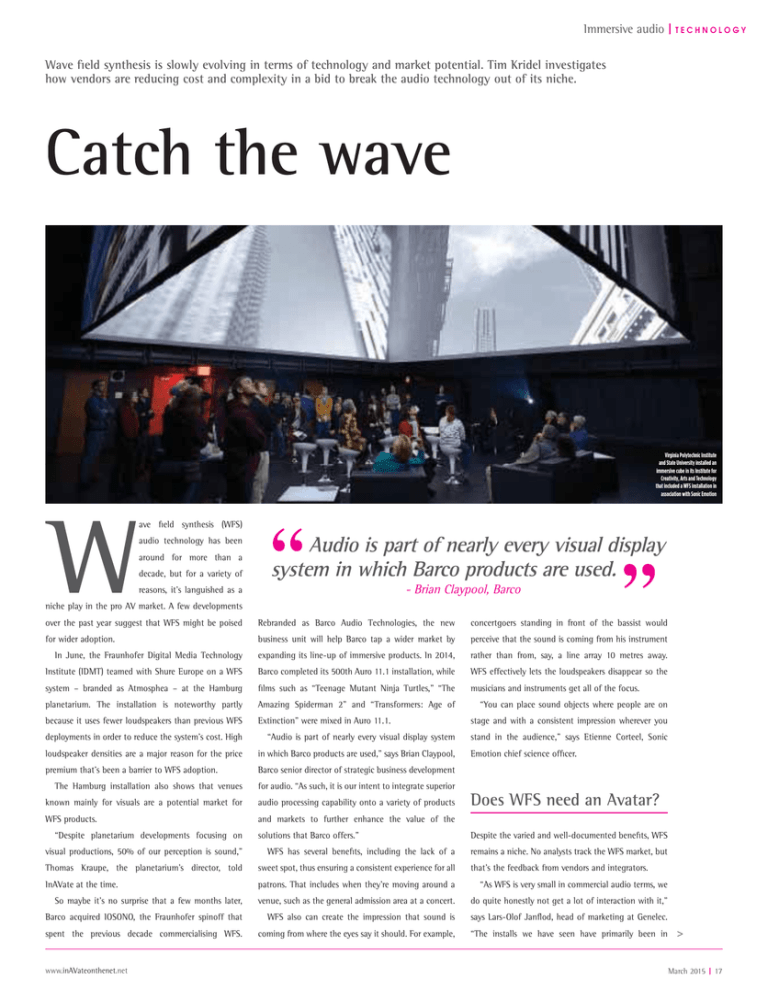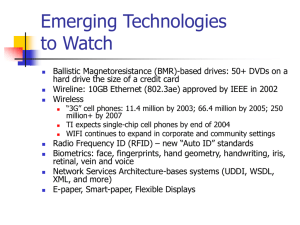Catch the wave
advertisement

Immersive audio | T E C H N O L O G Y Wave field synthesis is slowly evolving in terms of technology and market potential. Tim Kridel investigates how vendors are reducing cost and complexity in a bid to break the audio technology out of its niche. Catch the wave Virginia Polytechnic Institute and State University installed an immersive cube in its Institute for Creativity, Arts and Technology that included a WFS installation in association with Sonic Emotion W ave field synthesis (WFS) audio technology has been around for more than a decade, but for a variety of Audio is part of nearly every visual display system in which Barco products are used. - Brian Claypool, Barco reasons, it’s languished as a niche play in the pro AV market. A few developments over the past year suggest that WFS might be poised Rebranded as Barco Audio Technologies, the new for wider adoption. concertgoers standing in front of the bassist would business unit will help Barco tap a wider market by perceive that the sound is coming from his instrument In June, the Fraunhofer Digital Media Technology expanding its line-up of immersive products. In 2014, rather than from, say, a line array 10 metres away. Institute (IDMT) teamed with Shure Europe on a WFS Barco completed its 500th Auro 11.1 installation, while WFS effectively lets the loudspeakers disappear so the musicians and instruments get all of the focus. system – branded as Atmosphea – at the Hamburg films such as “Teenage Mutant Ninja Turtles,” “The planetarium. The installation is noteworthy partly Amazing Spiderman 2” and “Transformers: Age of because it uses fewer loudspeakers than previous WFS Extinction” were mixed in Auro 11.1. deployments in order to reduce the system’s cost. High “Audio is part of nearly every visual display system loudspeaker densities are a major reason for the price in which Barco products are used,” says Brian Claypool, premium that’s been a barrier to WFS adoption. The Hamburg installation also shows that venues stage and with a consistent impression wherever you stand in the audience,” says Etienne Corteel, Sonic Emotion chief science officer. Barco senior director of strategic business development for audio. “As such, it is our intent to integrate superior known mainly for visuals are a potential market for audio processing capability onto a variety of products WFS products. and markets to further enhance the value of the “Despite planetarium developments focusing on “You can place sound objects where people are on solutions that Barco offers.” Does WFS need an Avatar? Despite the varied and well-documented benefits, WFS visual productions, 50% of our perception is sound,” WFS has several benefits, including the lack of a Thomas Kraupe, the planetarium’s director, told sweet spot, thus ensuring a consistent experience for all remains a niche. No analysts track the WFS market, but InAVate at the time. patrons. That includes when they’re moving around a “As WFS is very small in commercial audio terms, we that’s the feedback from vendors and integrators. So maybe it’s no surprise that a few months later, venue, such as the general admission area at a concert. do quite honestly not get a lot of interaction with it,” Barco acquired IOSONO, the Fraunhofer spinoff that WFS also can create the impression that sound is says Lars-Olof Janflod, head of marketing at Genelec. spent the previous decade commercialising WFS. coming from where the eyes say it should. For example, “The installs we have seen have primarily been in www.inAVateonthenet.net > March 2015 | 17 TECHNOLOGY | Immersive audio Work behind the scenes for WFS installation in the cube at Virginia Polytechnic Institute and State University research applications or applications closely linked to > research.” Sonic Emotion also worked with the Schauspiel Stuttgart. Copyright: Matthias Dreher Another reason is that WFS typically is deployed in high-end venues because those are the ones that can applications and reduced cost. This is what we have been actively pushing towards since 2010.” The terms “WFS” and “3D sound” often are used afford it. Cost – a by-product of WFS’ complexity – is a Sonic Emotion’s Sonic Wave 1 processor aims to interchangeably in pro AV. The 3D video market got a major reason why the technology hasn’t found a wider make WFS viable for a wider variety of applications by boost when films such as “Avatar” prompted theatres market. reducing the system cost and number of loudspeakers, to upgrade their equipment. Although the Hamburg “The processing equipment is very expensive, and planetarium gets about 300,000 visitors annually, it you do need a lot of loudspeakers, which apart [from] “We compromised a little in terms of precision, but would take thousands of comparably trafficked venues purchasing them will also cost a lot to install,” Janflod that’s it. That’s really minimal,” Corteel says. “We also worldwide to drag WFS into the consumer mainstream says. both by a factor of 10. made it possible to use standard speakers: compact, and thus encourage other organisations to view the WFS vendors concede that point. technology as something their patrons would expect “Classical WFS, with a frame-to-frame speaker At the Tonmeistertagung conference in November, or even prefer. “I think the main reason [why WFS isn’t more common] is the lack of a commercial push like you have with the film industry,” Janflod says. “When low power.” configuration, is not a low-cost solution as the Corteel co-presented a paper explaining how Sonic magnitude of the experience demands a significant Emotion achieved that feat: “The WFS algorithm amount of speakers and processing,” Stepputat says. integrated in the Sonic Wave I processor... [uses] a small That’s changing. For example, loudspeakers don’t number of high power/efficiency loudspeakers that are Spielberg introduced the film ‘Jurassic Park,’ cinemas who wanted to screen it needed to upgrade their systems to do the soundtrack of the film justice. “It is interesting to see what is happening in cinema 3D sound from the likes of Auro Technologies and Dolby with their Atmos system. Both are soon ready to release processors affordable in price for the normal consumer and thus there is a much broader foundation The processing equipment is very expensive, and you do need a lot of loudspeakers, which apart [from] purchasing them will also cost a lot to install. - Lars-Olof Janflod, Genelec for commercial success than with WFS. “Genelec does not make systems for the actual cinema theatre but for the production houses of the have to be as densely packed as they once were. content. We get enormous interest for the demos we “With the latest algorithms from Fraunhofer, it is the stage) for homogeneous level range distribution do at trade shows and other events with Auro 3D and now possible to do a wider [spacing]: 1.5 metre or and spatial sound reproduction keeping all benefits of Dolby Atmos technology.” so between,” says Torsten Haack, Shure Distribution WFS. system group director. Fewer speakers also should help WFS expand into A high-end experience At least for now, WFS is synonymous with “high-end” 18 | March 2015 often distributed over two levels (above and on/below the large-venue market. “The loudspeakers located on or below stage can be considered as a ‘spatial’ front fill array. The loudspeaker ensemble typically spans the entire stage width using “WFS is limited in its sound reinforcement capabilities eight to 16 wide dispersion speakers (5 to 8 inches in large venues as WFS is best achieved in smaller and coaxial or asymmetric directivity speakers with wide horizontal dispersion). Three to seven loudspeakers for several reasons. One is that the immersive experience mid-sized venues – like cinema, for example – using is different than what most people are accustomed to. appropriately sized individual speakers,” Stepputat are commonly used above the stage targeting “In most cases, when somebody is experiencing WFS says. “Once you extend this approach to work with homogeneous level coverage further back in the room. in a reasonable application, they will give a positive more sparsely populated speaker configurations and evaluation as it is a very high-end technology,” says speakers that will fulfil certain sound reinforcement loudspeakers Olaf Stepputat, Barco Audio Technologies director. requirements, you will find a broader range of useful horizontal dispersion, directive behaviour along the “Loudspeakers should either be point source with asymmetric directivity (wide www.inAVateonthenet.net > TECHNOLOGY | Immersive audio Atmosphea also bundles multiple applications onto With the latest algorithms from Fraunhofer, it is now possible to do a wider [spacing]: 1.5 metre or so between [speakers]. a single platform, with WFS residing in one core of a quad-core DSP. “The WFS circuits coexist with EQs and all the other audio components on the system, and the system incorporates more applications at a time than just - Torsten Haack, Shure Distribution WFS,” Haack says. “This is one of the big benefits of vertical dimension) or line arrays with preferably wide into a single platform. That strategy could make sales horizontal dispersion. Typical LCR configurations are among customers that otherwise would balk at the applicable with two large line arrays on either side of standalone cost of WFS. > the stage and a central cluster.” “You get WFS almost free [of charge] considering Sonic Emotion also bundles WFS with multiple other systems, such as EQ and loudspeaker management, that you can get rid of all that equipment,” Corteel Atmosphea.” More flexibility and less complexity says. Corteel’s Tonmeistertagung paper also showed how Wave 1 could be integrated with Studer digital mixing consoles. In this setup, sound engineers can control the audio source placement in the 3D field directly from a Studer Vista’s source channel strip. The placement can City library Genk runs on AUDAC be done directly from the source channel’s Vistonics surround-pan rotaries or with the console’s joystick. Finally, WFS also benefits from the way that computing power keeps increasing. That enables multiple wave fields for reconfigurable rooms, and allows WFS systems to accommodate a wider variety of room shapes. “Up to now, it was not possible to do this because of processing power, which was never there as we have today,” says Shure’s Haack. “We can put loudspeakers in any shape of building. It can be cubic. It can be [cylindrical].” Increasing computing power also eventually could make WFS systems easier to design and install. “I can image that someday that where will be some measuring tools and training so a wider variety of our partners are able to do this,” Haack says. For now, integrators and other AV pros can turn to WFS vendors for help. In the meantime, those that have experience with WFS are using it for more than permanent installations. For example, Sonic Wave 1 was used for the Paris Jazz Festival and Classique au Vert festivals, which featured an open-air concert stage MTX series Web-based multizone audio matrix and 1,400 seats in a fan-shaped configuration, with another 2,000 standing behind them. The WFS system consisted of a standard LCR line array configuration with five D&B Q1 for the left and right clusters, and for D&B Q1 for the centre The MTX series offers you the ideal solution for your project. Any external device like paging modules, input sources or control panels can be connected, all operating in a different zone. To control the MTX, you just choose the option that suits you best : the web-based user interface, additional control panels or the iPhone or iPad Remote app. Discover the full matrix system series on www.audac.eu/matrix Visit us at Prolight & Sound cluster. On stage, 10 L-Acoustics 108P are used as a WFS front fill. More than 60 shows – ranging from solo piano to classical orchestra and jazz ensembles – used the system, with no adjustments to the speaker positions. That’s important because Sonic Emotion’s goal was to make WFS viable for touring rather than limiting the addressable market to permanent live installations. Hall 8.0 Stand nr F21 20 | March 2015 www.inAVateonthenet.net



